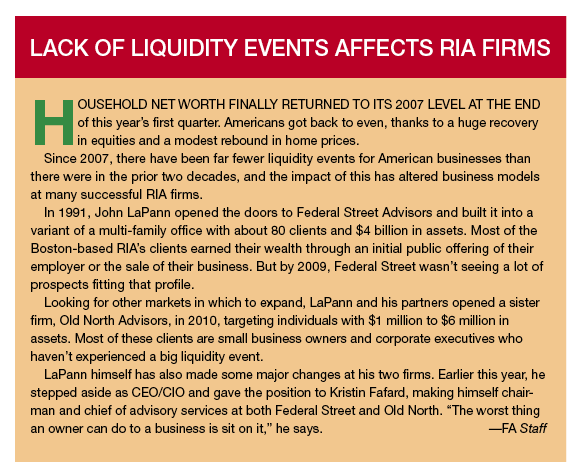In these situations, advisors can help by urging business owners to get a comprehensive appraisal by someone familiar with their industry. That can produce a hard number so the advisor and the client will have a good idea of how much will be available for reinvestment to generate retirement income.
Business owners might not welcome such advice. A thorough appraisal can be extremely expensive, for one thing. Also, they might be reluctant to “go public” with a valuation, alarming employees and customers. “They think the word will get out,” says Kamen, “especially if they’re in a small industry. We suggest that business owners avoid accounting and valuation firms in their circle, for this purpose. They might go out of the area, even to another state, for an expert appraiser.”
A comprehensive appraisal may not necessarily be welcomed, even if the estimate runs into the eight figures. An owner selling a business for $10 million, for example, might net $8 million or less after tax.

Quitting Time
Business owners who find that their company’s likely selling price won’t provide them with a desirable retirement can simply decide to keep working. Generally, that solution will have limits. “What was fine at age 45 is not as much fun at age 65,” says Carter. “Business owners might have health issues or just get tired of working. When they see their peers traveling or spending time with the grandchildren, they may not want to keep getting to the office by 6 o’clock every morning.”
Therefore, working indefinitely is not usually a practical answer for business owners. They might stay on the job until they literally can’t do it anymore, then sell the company to the highest bidder. At that point, though, a desperate seller is in a poor negotiating position.
Instead, advisors can urge clients to start succession planning in advance and exit with the best possible terms. Brendan Burke, director of business development at Headwaters MB, an investment banking firm in Denver, suggests starting the process at least 18 to 24 months before the target retirement date.
One approach to succession planning is to look for a successor, someone who’ll take over from the business owner. “It’s usually important to find a successor who is capable of running the company well,” says Carter. “Clients who are long-term business owners tend to be emotionally attached to the company, to their customers and to their employees. The owner’s name might be on the door, even after the sale [or transition to a sale], and the owner may be upset if the business is mismanaged.”
As Carter notes, a successor’s failure may put the company back into the hands of the business owner, who is then older and even less eager to continue running a now-devalued enterprise. Depending on the terms of the deal, the business owner’s full selling price may depend on some sort of earn-out, requiring continued success, while “clawbacks” might be triggered if the post-sale business falters. (A clawback clause can require the seller to repay money already received if certain goals aren’t met.)
For all of these reasons, a valid succession plan requires a qualified successor. The owner’s family is a natural place to start looking, but the challenge may be finding a relative both capable and willing to take over. “Working with a business-owner client, we recently identified the owner’s son as a likely successor,” says Cheryl Holland, president of Abacus Planning Group in Columbia, S.C. “However, the son said that while he was good at some things, he wasn’t good at all the things he’d need to be able to run the company well.”
This heir apparent was only 25 years old, and his understanding of his weaknesses as well as his strengths impressed Holland, who says that about one-third of her clients traditionally have been business owners. “We listened to the young man,” Holland explains, “and realized we could create an environment where he would feel safe as the business owner. It took a few tries, but he came around. We ultimately worked out a plan where the client’s son would take over the business but would share management responsibilities with three other employees with experience there.”








